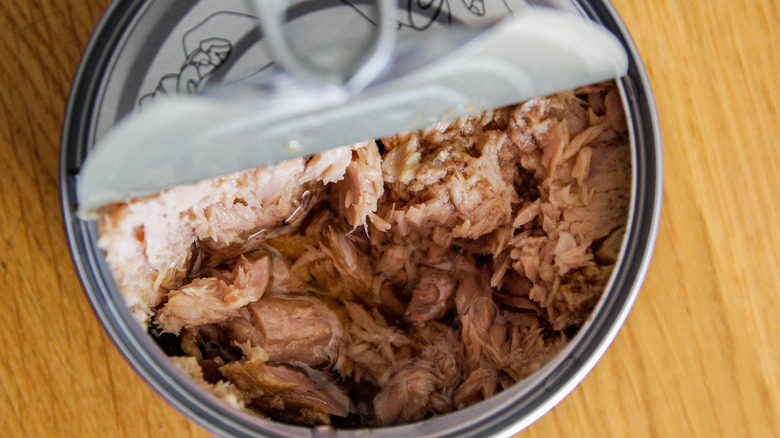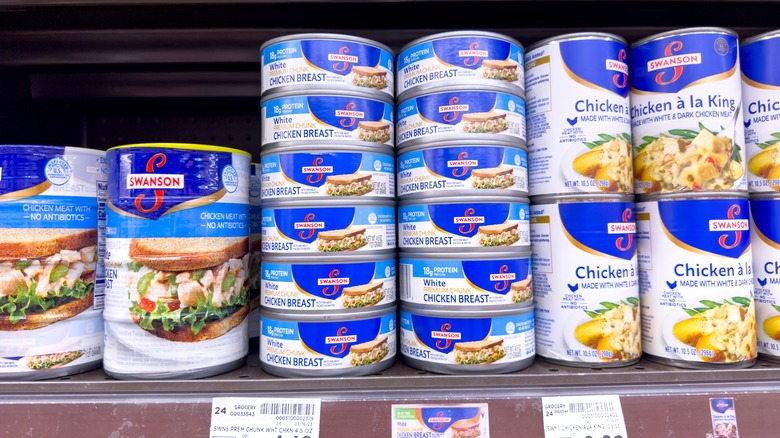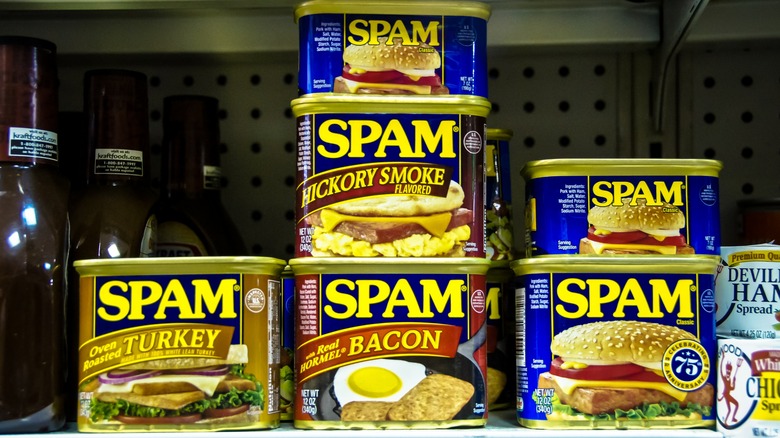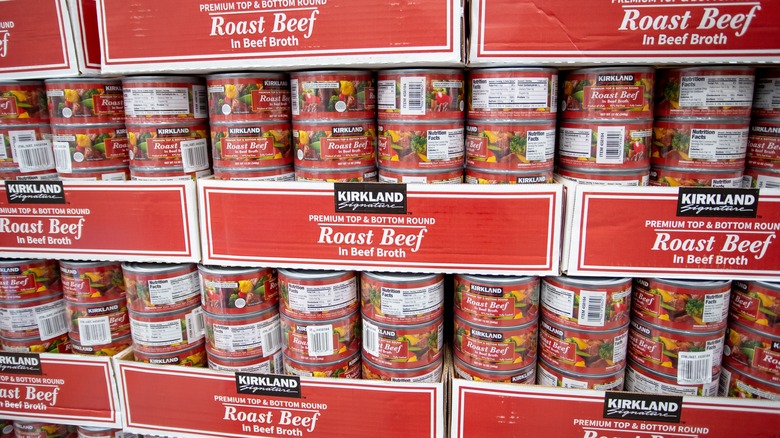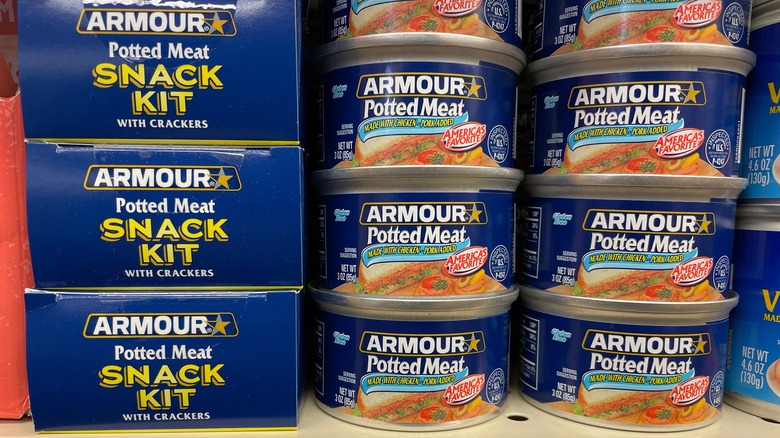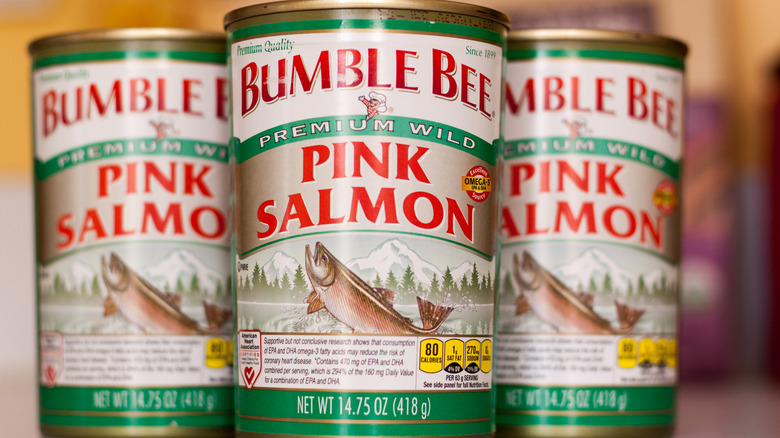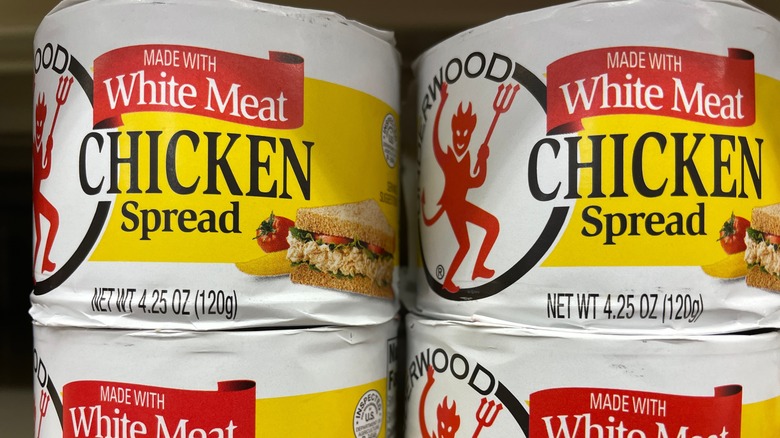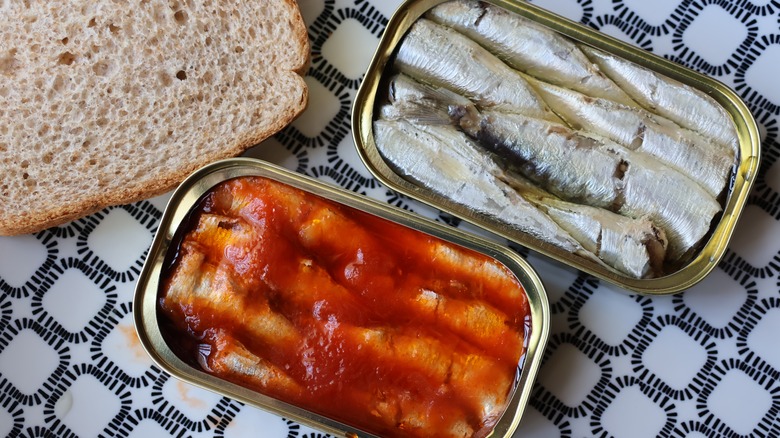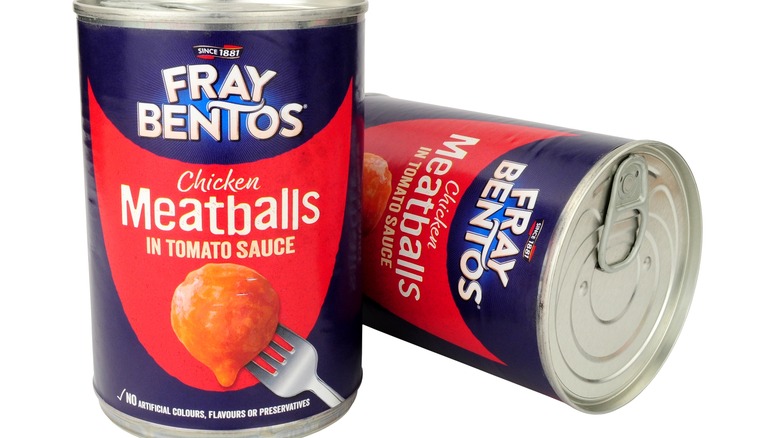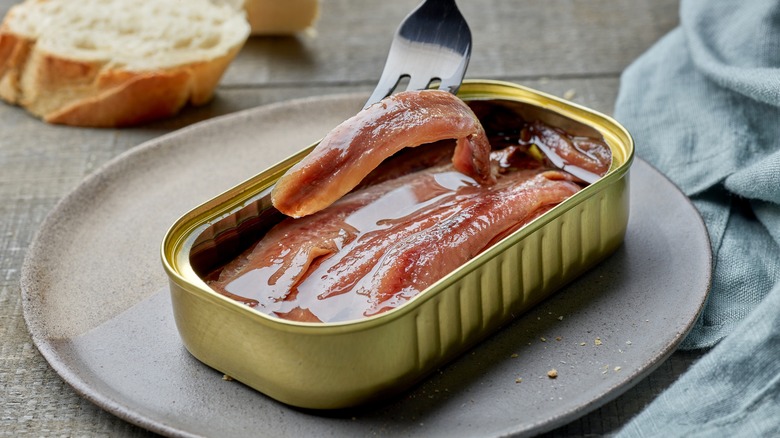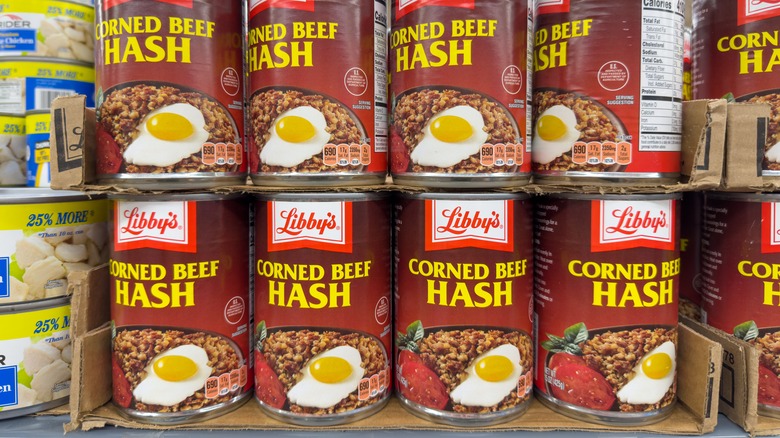6 Canned Meats You Should Be Eating And 6 To Avoid
We may receive a commission on purchases made from links.
Canned foods come with lots of benefits. They're affordable and convenient. And with proper storage they will last for a substantial amount of time in your pantry. Why would you not love canned foods?
Well, while some canned foods are all of the above — and so much more — all canned food is not created equal. Whole chicken in a can? Bleh. Ribs in a can? That's just kinda weird, no? There's a reason why some of these canned meats have gone the way of the dodo bird. That said, you can still find plenty of canned meats on the grocery store shelf — so which should you add to your pantry and which should you forego, opting instead for a non-canned alternative?
Here are some of the canned meats you should eat and some you should avoid, based on factors such as widespread availability, convenience (compared to preparing the meat fresh), versatility, quality, nutrition, and price.
Eat: Tuna
Yes, if you crack open a tin of tuna at your desk at the office, you're going to get a little bit of side-eye or even a few verbal complaints. Canned tuna can be smelly, but this canned meat makes up for that fact in myriad ways, with tons of benefits that will have you stocking up on this pantry staple, stat.
First of all, canned tuna is widely available, with a broad range of options available to you in most major grocery stores. Step into your neighborhood Walmart and you've got Albacore wild tuna, yellowfin tuna in olive oil or vegetable oil, chunk light tuna in water, no salt-added tuna, etc. You can choose from a variety of brands and, if you're really on a budget, you can get a can for under $1.
Once you open that can, the magic happens. Canned tuna is extremely versatile with a range of genius uses. You're not just limited to tuna salad or tuna casserole. Add it to pasta. Make fish tacos or quesadillas. Make a dip. All the while, you'll enjoy all of canned tuna's nutritional benefits. It's low in calories while being high in protein and omega-3 fatty acids, as well as iodine, selenium, and vitamin D.
Avoid: Vienna sausages
Vienna sausages have one thing going for them: They're cheap, one of the cheapest canned meats on this list. You can purchase a can for under $0.80 at Walmart. Unfortunately, that's where Vienna sausages' benefits begin and end.
Not to be confused with the original Vienna sausages that are long, skinny, and much like a hot dog, canned Vienna sausages are short, stubby, and floating in a broth — offered in a mixture of chicken, beef, and pork ground into a consistency that you might find in a poor-quality hot dog or bologna. Compared to canned tuna or chicken, these sausages are highly processed and the nutrition facts leave a lot to be desired.
For example, a serving of Libby's Vienna sausages in chicken broth come with nearly 30% of your recommended daily cholesterol and more than a third of your daily recommended sodium. Additionally, the sausages contain sodium nitrite, an ingredient that's commonly found in highly processed meats and that's also been linked to colorectal cancer. Then, there's the main ingredient: mechanically-separated chicken. While that's not unhealthy in and of itself, it's unappealing. According to the U.S. Department of Agriculture, mechanically-separated meat can be likened to a paste or cake batter and it's made by basically applying pressure to a piece of meat — bones and all — until the meat and bones separate. The process has received scrutiny in the past, and now mechanically-separated beef is considered unsafe for human consumption.
Eat: Chicken
Very similarly to tuna, canned chicken is a convenient and versatile pantry ingredient. There are many different brands and types of canned chicken at the grocery store, and available at a variety of price points. While you might not be able to get a can of chicken for as cheap a price as a can of tuna, it's still pretty affordable, at around $1 per can at the lowest price point.
Canned chicken is also significantly more convenient than fresh chicken. With canned chicken, there's no heating up a pan or the oven, and no worries of salmonella if you don't cook the chicken all the way or if you accidentally splatter a little chicken juice on the countertop and forget to quickly wipe it up (did you know that one in every 25 packages of fresh chicken contain salmonella, according to the Centers for Disease Control and Prevention?). Canned chicken is ready to go when you are. The only prep needed is to pop the top off that can.
When you have canned chicken, use it anywhere you might use shredded chicken — casseroles, soups, tacos, dips, quesadillas. You can even make chicken fries or strips. Canned chicken is also high in protein, zinc, selenium, niacin, and B vitamins.
Avoid: Spam
There are a lot of people who love Spam. It's highly popular in certain regions — in fact, there's a Spam museum in Austin, Minnesota. This canned food has stood the test of time, providing an inexpensive meat product in the 1930s and, from there, growing into the cultural icon that it is today. However, if you're trying to fill your pantry with the most versatile, highest-quality, most nutritious canned meats possible, you should probably leave Spam off your shelf.
While Spam does only contain six ingredients, including pork, salt, water, potato starch, sugar, and sodium nitrite, do note that sodium nitrite is linked to colorectal cancer. Additionally, with salt standing in as the second ingredient in Spam, you can expect quite a lot of it in every bite. In each serving of classic Spam, you'll find exactly a third of your daily recommended sodium, as well as a fourth of your daily recommended total fat, and 30% of your recommended saturated fat. And the amount of cholesterol in Spam isn't great at 40 milligrams — that's more than 10% of your daily recommended intake.
Eat: Roast beef
Canned chicken and canned tuna are a little easier to get behind than canned roast beef — likely because it's not as widely used or available. Admittedly, it's also not the most visually attractive.
However, those considerations aside, canned roast beef is still a canned food you should consider adding to your grocery list for its convenience, versatility, price, and nutrition. Like chicken or tuna, canned roast beef comes in "chunk" form, though usually in a gravy or sauce rather than water or oil. From there, you can use it anywhere you might use shredded or chunked beef, such as a casserole, stew or soup, or even barbecue sandwiches. There's no need to buy an expensive cut of beef and then cook it for hours or all day. The canned roast beef is at the ready. And this Amazon reviewer had this to say about Kirkland's canned roast beef: "A great tasting and quick solution for a very flavorful meal. Highly recommend it."
Avoid: Potted meat
Going head to head with Vienna sausages for the cheapest canned meat on our list, you can buy a can of potted meat for under $0.70 — but why would you want to? If you're not familiar with potted meat, it's actually quite historic. Before the advent of modern food preservation methods (like refrigeration), home cooks would slow cook meat for a very long time and then seal it in a container, like a pot. The result was something not dissimilar to confit or rillettes, but that's a comparison you would never make when popping open a can of modern potted meat from the grocery store.
One Reddit user described it as similar to ground up Vienna sausages or ground up, wet hot dogs. One Facebook user compared it to how they would think wet dog food might taste. It's true that potted meat does have a very spreadable, thick, meat-paste consistency. Made from mechanically-separated chicken, it also contains the cancer-linked sodium nitrite. As for nutrition, it comes with 40% of your daily recommended sodium and 21% of your daily recommended total fat.
Eat: Salmon
Salmon is well known as a healthful fish, but buying fresh salmon and then cooking it can sometimes turn off novice home cooks who haven't worked with much seafood, relegating this ingredient to restaurant-only dinners. However, for even the most unsure home cook, canned salmon can be an easy, convenient, affordable, and nutritious alternative. In fact, you can even get more health benefits from canned salmon than you might from fresh salmon. Canned salmon has been shown to contain higher levels of calcium than fresh salmon because of the edible bone bits inside the can.
Additionally, canned salmon has as many (or more) vitamins than fresh salmon, such as B vitamins. You can eat it directly out of the can, but it can also be used in a variety of recipes, from dips to rice bowls, casseroles to quiche. If you're worried about quality, rest assured that it is possible to find very high-quality canned salmon brands, such as Wild Planet, Faust, and Rubinstein's.
Avoid: Chicken spread
Don't make the mistake of thinking that chicken spread and potted meat are the same thing. Though there are similarities, as both are spread-able canned meat products, and both contain chicken, there are also some differences.
Chicken spread is more of a finely chopped chicken consistency, rather than a paste consistency. Additionally, it's not made with mechanically-separated chicken. Instead, the most familiar brand of chicken spread, Underwood – you might recognize the little pitchfork-wielding devil on the can — uses white chicken meat as its first ingredient, followed by chicken broth, a blend of seasonings, and a few other ingredients. The nutrition facts may not be as bad as what you'll get from potted meat, either, but a serving still comes with nearly 20% of your daily recommended sodium, and 15% of your daily recommended saturated fat — and that's if you eat just a serving and not the whole can. If you eat the whole can, you can double those numbers.
At its core, canned chicken spread is really like a very basic chicken salad ... in a can. That begs the question: While it might be slightly less convenient and more time consuming, shouldn't you just buy canned chicken and make your own basic chicken salad yourself, if it means a higher-quality and healthier meal?
Eat: Sardines
While canned salmon and canned tuna have been pretty mainstream for a while, over the last few years, other canned seafood (hello canned sardines!) has been growing in popularity, trending on social media and in restaurants. If you've yet to jump on this trend, though, consider doing so with canned sardines.
Canned sardines come with a range of health benefits. Sardines contain healthy fats, nutrients, and vitamins that support heart health, bone health, and brain health. Plus, sardines are the fish with the lowest mercury levels, so if you love seafood but are worried about eating too much mercury, sardines are the way to go.
While the various ways you can use canned sardines may not be as obvious as the various ways you can use canned tuna or chicken, the options are still abundant. You can air fry sardines for a crispy snack. And you can add canned sardines to a charcuterie board or to a salad. They're also an excellent choice in a pasta sauce. Some people prefer to eat sardines straight from the can, with maybe crackers and a squirt of mustard or hot sauce.
Avoid: Meatballs
In the United States, if you encounter a meatball in a can, chances are that meatball is accompanied by some pasta (probably some iconic canned pasta shaped like an 'O'). Canned meatballs are more common in other parts of the world, such as the United Kingdom. So, even if you really wanted to stock up on canned meatballs, sans 'O's, they might not be readily available.
So let's say you stick with what is available. The meatballs in a can of SpaghettiO's are made with mechanically-separated chicken and beef, but water is the very second ingredient, right after chicken and before beef or bread crumbs. Additionally, it's unlikely you're going to eat the meatballs without the 'O's and those come with their own issues, such as high fructose corn syrup, which equals a litany of health issues, negatively impacting your liver and waistline, and increasing your chances of developing diabetes, heart disease, and cancer, among other disease. Plus, eating a whole can of SpaghettiO's with meatballs comes with more than 40% of your daily recommended sodium, and nearly 20% of your daily recommended added sugar.
Eat: Anchovies
Like tinned sardines, tinned anchovies get looked over when you're considering canned meat options, mostly because the average American's only experience with anchovies is when this fish is plopped on a pizza. However, there are far more uses for this delicious, convenient tinned fish. Make an anchovy vinaigrette for your next salad, or use as a tasty appetizer of crackers topped with hard-boiled egg and a caper-stuffed anchovy. Add anchovies to a sandwich or slice of toast. However you use them, a can of sardines will provide a super delicious burst of umami.
As you enjoy your canned anchovies, you'll also enjoy anchovies' health benefits, including omega-3 fatty acids, selenium, niacin, vitamin B12, vitamin A, calcium, and potassium. Like sardines, anchovies are also relatively low in mercury, as compared to other seafood. The economic downside that comes with tinned fish like anchovies (or sardines) is that these less-popular fish can sometimes be a little more expensive than their canned tuna and salmon counterparts.
Avoid: Beef hash
Corned beef hash is something you can make at home, from scratch, and it's delicious. Pack it in a can, though, and things go south. Basically just a can of beef with processed potatoes, some seasonings, and preservatives, corned beef hash takes all the dicing and slicing off your plate and makes the process of putting breakfast on the table as easy as opening a can and heating up the hash.
Unfortunately, while convenient, canned corned beef hash isn't the prettiest canned food item on the planet (Reddit users have compared it to looking like dog food, even if they do like the flavor). It also comes packed with ingredients like sodium nitrite that have been linked to cancer, and plenty of fat and sodium. Armour's corned beef hash packs in a whopping 65% of your daily recommended saturated fat (plus 2 grams of trans fat) per serving, alongside 41% of your daily recommended sodium and 27% of your daily recommended cholesterol. Meanwhile, Libby's corned beef hash comes with 55% of your daily recommended saturated fat per cup, 1.5 grams of trans fat, 55% of your daily recommended sodium — and it has 23% of your daily recommended cholesterol per serving.

